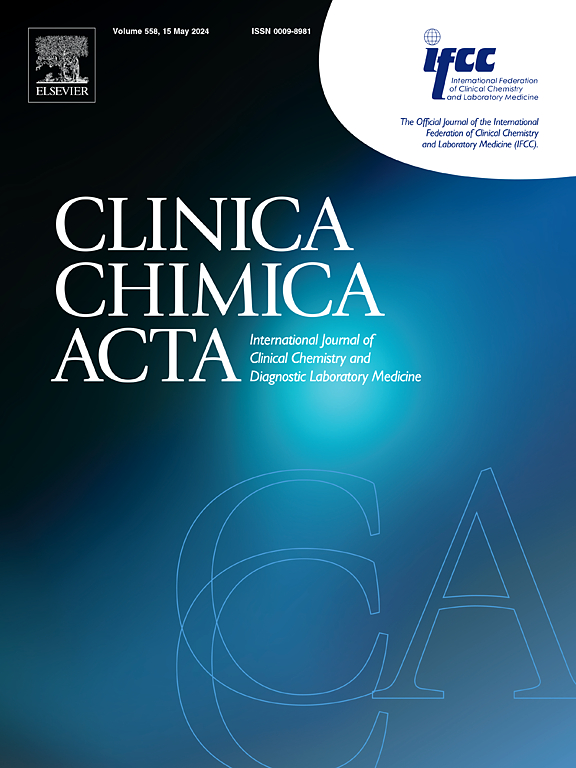Standardising EQA submissions with automated defactoring of post-analytical correction factors
IF 3.2
3区 医学
Q2 MEDICAL LABORATORY TECHNOLOGY
引用次数: 0
Abstract
Post Analytical Correction Factors are routinely applied by clinical laboratories to align results from different instruments, methods, or because of the need to maintain consistent results in the face of lot-to-lot reagent variation, or if a new method introduces a bias compared to the technique from which the reference interval was derived. In any of these situations, some procedures must be followed to ensure that the factor used to align results from different methods, procedures, or reagents is valid and robust.
In addition to the problems a laboratory faces in deriving and managing these factors, poorly described procedures exist for submitting results for External Quality Assurance (EQA) challenges. Should the participant submit the factored or unfactored result? Should the laboratory remain with its peer method group or report the result it would to a laboratory referrer?
If the EQA material is commutable, the corrected bias should not be removed for the EQA purpose of laboratory assessment. However, it should be removed for metrological traceability between different instruments.
If the EQA material is not commutable, the corrected bias should be removed for laboratory assessment. Non-commutable EQA material cannot be used to evaluate metrological traceability.
The Royal College of Pathologists of Australasia Quality Assurance Programs (RCPAQAP) has a policy of treating the EQA sample as if it were a patient but manually defactoring the final submitted results to enable valid peer group comparisons. However, there is evidence that not all laboratories complied with this policy, making it challenging to identify and troubleshooting biases.
A Factor/defector tool was developed to automatically defactor submitted results applied to survey results and allow laboratories to flag and reverse PACFs during data submission. This standardises EQA submissions across institutions, regardless of LIS or middleware configurations.
通过分析后校正因子的自动分解来标准化EQA提交
临床实验室通常使用分析后校正因子来校准来自不同仪器、方法的结果,或者因为在面对批次之间的试剂变化时需要保持一致的结果,或者如果一种新方法与衍生参考区间的技术相比引入了偏差。在任何这些情况下,必须遵循一些程序,以确保用于校准来自不同方法、程序或试剂的结果的因素是有效和稳健的。除了实验室在推导和管理这些因素方面面临的问题之外,在提交外部质量保证(EQA)挑战的结果时存在描述不佳的程序。参赛者应该提交因子化或未因子化的结果吗?实验室应该继续与同行方法组合作,还是将结果报告给实验室推荐人?如果EQA材料是可交换的,则不应为了实验室评估的EQA目的而消除校正偏差。但是,为了不同仪器之间的计量可追溯性,它应该被移除。如果EQA材料是不可交换的,则应消除校正后的偏差以进行实验室评估。不可交换的EQA材料不能用于计量溯源性评价。澳大利亚皇家病理学院质量保证计划(RCPAQAP)有一项政策,将EQA样本视为患者,但手动分解最终提交的结果,以便进行有效的同行组比较。然而,有证据表明,并非所有实验室都遵守这一政策,这使得识别和排除偏见变得具有挑战性。开发了一个因子/叛逆者工具,用于自动分解应用于调查结果的提交结果,并允许实验室在数据提交期间标记和反转pacf。这使得跨机构的EQA提交标准化,而不考虑LIS或中间件配置。
本文章由计算机程序翻译,如有差异,请以英文原文为准。
求助全文
约1分钟内获得全文
求助全文
来源期刊

Clinica Chimica Acta
医学-医学实验技术
CiteScore
10.10
自引率
2.00%
发文量
1268
审稿时长
23 days
期刊介绍:
The Official Journal of the International Federation of Clinical Chemistry and Laboratory Medicine (IFCC)
Clinica Chimica Acta is a high-quality journal which publishes original Research Communications in the field of clinical chemistry and laboratory medicine, defined as the diagnostic application of chemistry, biochemistry, immunochemistry, biochemical aspects of hematology, toxicology, and molecular biology to the study of human disease in body fluids and cells.
The objective of the journal is to publish novel information leading to a better understanding of biological mechanisms of human diseases, their prevention, diagnosis, and patient management. Reports of an applied clinical character are also welcome. Papers concerned with normal metabolic processes or with constituents of normal cells or body fluids, such as reports of experimental or clinical studies in animals, are only considered when they are clearly and directly relevant to human disease. Evaluation of commercial products have a low priority for publication, unless they are novel or represent a technological breakthrough. Studies dealing with effects of drugs and natural products and studies dealing with the redox status in various diseases are not within the journal''s scope. Development and evaluation of novel analytical methodologies where applicable to diagnostic clinical chemistry and laboratory medicine, including point-of-care testing, and topics on laboratory management and informatics will also be considered. Studies focused on emerging diagnostic technologies and (big) data analysis procedures including digitalization, mobile Health, and artificial Intelligence applied to Laboratory Medicine are also of interest.
 求助内容:
求助内容: 应助结果提醒方式:
应助结果提醒方式:


